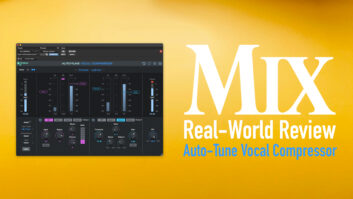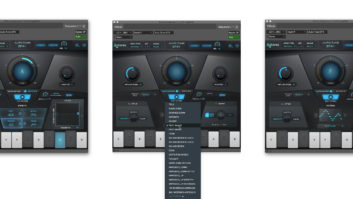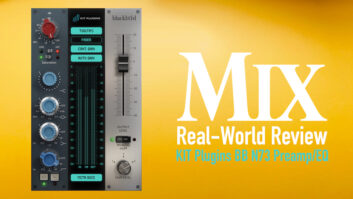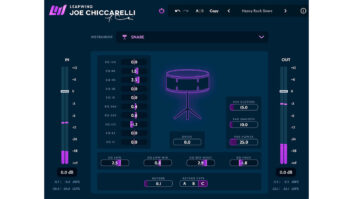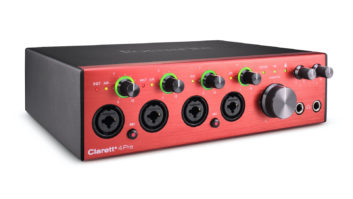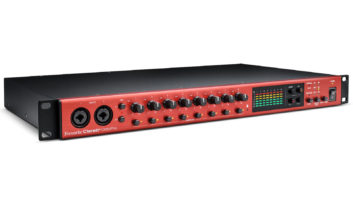Available in both software and hardware versions, Auto-Tune corrects the intonation of vocals and instruments, resulting in sweeter-sounding tracks and relieving studio engineers of the gnawing tedium of endless punch-ins to capture takes that sound in-tune. Auto-Tune did not change much since it was introduced a few years ago, until the recent introduction of Auto-Tune 3. The new version — available as a software plug-in only — brings a host of fresh and powerful features to the party, including a mode for tuning bass instruments, the ability to recognize absolute time (for some host applications only), phase-coherent pitch correction of stereo tracks, high sample rate (up to 96 kHz) compatibility, and super-cool MIDI functions that allow you to easily and quickly tackle weird scales and songs that modulate.
SYSTEM REQUIREMENTS
I reviewed the MAS plug-in version of Auto-Tune 3 ($399; see sidebar for prices of other versions) using Digital Performer 2.72. Like other Mac plug-in versions — TDM, RTAS and VST — the MAS plug-in requires a PowerPC processor and Mac OS 8.6 or later. Additionally, Pro Tools users must use a PCI TDM (not NuBus) system and Pro Tools III or later. A DirectX version is available for PC users; Version 6.1 or later DirectX Media Runtime is recommended. Antares was considering producing a PC RTAS version at press time. Of course, you’ll also need a host program (e.g., MOTU’s Digital Performer) that supports the appropriate plug-in architecture for the Auto-Tune version you’ll be using.
NEW LOOK, SMARTER BRAINS
The graphics may have changed with Auto-Tune 3, but users of the old Auto-Tune program will feel right at home. Many of the changes are cosmetic, but Antares made using the Graphical mode more intuitive. All of the old functions — including Retune, Tracking, Scale Detune and Vibrato — are retained. And you’ve got all the major, minor and chromatic, as well as 26 historical, ethnic and microtonal scales for pitch correction at your disposal to handle any musical style on Earth.
Auto-Tune 3’s core pitch-detection algorithm has been improved in both Automatic and Graphical modes, and a new “input-type” drop-down menu further improves pitch detection and correction by allowing you to specify the pitch range your vocal or instrument source lies within. Your five choices for input type are soprano; alto/tenor or low male voice; instrument; and bass instrument. Choose instrument when your axe goes down no lower than 55 Hz (A0). The bass instrument setting will recognize and correct pitches that are over an octave lower, down to 25 Hz. Auto-Tune 3 can distinguish pitches as high as C6.
Auto-Tune 3 can now treat stereo tracks, and Antares asserts that Auto-Tune 3 will maintain phase-coherent pitch correction while doing so. You choose which side of the stereo pair — left or right — will be used for Auto-Tune’s pitch reference. For the best results, make sure you choose the cleanest track with the least amount of ambient noise.
Auto-Tune 3 also allows you to select either of two alternate Auto Mode functions that work in conjunction with MIDI input from your keyboard: Learn Scale from MIDI allows you to define a custom scale before you begin playback, and Target Notes via MIDI empowers you to change target pitches on-the-fly. Both functions require a host application that can route MIDI to an audio track’s plug-in to serve as a sidechain signal of sorts. Auto-Tune’s manual leaves you guessing as to how this is done, so here’s the scoop: In DP (Digital Performer), first make sure the “Inter-application MIDI” option in the FreeMIDI Preferences dialog box is checked. Auto-Tune 3 then shows up as an output choice in DP’s Tracks window. Assign Auto-Tune 3 to be the output for any track receiving input from your MIDI keyboard. You can then either put the track into record-ready status so that live MIDI data can control Auto-Tune 3 or, alternatively, use prerecorded MIDI data in the track to control the plug-in.
The Learn Scale From MIDI function is best programmed when your tracks are not playing. It lets you define a scale by simply playing the notes on your MIDI keyboard. You can play the song’s melody without regard to tempo, and Auto-Tune can then use those notes as a scale for correcting the pitch of your lead vocal, for instance, once playback begins.
Unlike the Learn Scale From MIDI function, Target Notes via MIDI works best in real time during audio playback. Simply hold down multiple keys together to define what your target pitches will be for the current song section being processed. This is an awesome feature for use on songs that modulate from one key to another. As the song modulates into a new key, simply release the notes on your keyboard that don’t belong to the new key and add the other notes that do (along with any accidentals for the melody in the current song section). Auto-Tune 3 will follow your key changes in real time, making the appropriate changes in target pitches. MIDI keyboardists especially will love how fast they can work with Auto-Tune 3 through multiple key changes.
Auto-Tune 3 also recognizes absolute time within Mac MAS- and VST-host applications. This allows you to make multiple Graphical mode tweaks throughout your song and have the plug-in remember where each one lies with respect to timecode on subsequent playback. This new capability represents a major breakthrough in expediency, although it is not without fault, as I’ll discuss in a moment. And, unfortunately, RTAS and TDM users will still need to use host-application markers with Auto-Tune’s Graphical mode to lock the plug-in’s relative time reference to phrases to be processed. As of press time, Antares also knew of no DirectX applications that could feed Auto-Tune 3 an absolute time reference, although the DirectX architecture doesn’t necessarily preclude this capability.
Auto-Tune 3’s new sample rate display shows the current audio file’s sampling frequency. The plug-in supports 88.2 and 96kHz rates, as well as all the lower rates your host application can dish out. Antares also purports that the TDM version employs enhanced MIX chip-usage efficiency, allowing more instantiations per MIX chip.
TIME FOR A TUNE-UP!
I got wonderful results running electric bass guitar tracks through Auto-Tune 3 with the plug-in’s Bass Instrument setting chosen. The processing sounded virtually transparent and improved the pitch noticeably. On a peppy country music production, intentionally ghosted bass notes did not cause glitches in the processing and went through unchanged.
Choosing the correct input-type setting will improve your results. For example, the alto/tenor voice setting made pitch correction of male vocal glisses a tad more natural than the soprano voice setting. My A/B tests also confirmed that Auto-Tune 3 generally corrects pitch a bit faster and smoother than the plug-in Version 1.51.
Although the MAS version’s Graphical mode recognizes absolute start times in DP, it will not follow memory cycling. When audio loops back to the start of a memory cycle, Auto-Tune 3 continues to scroll onward from the memory cycle’s end point. But more importantly, Auto-Tune 3’s recognition of absolute start times now allows you to make multiple Graphical mode tweaks throughout your song, rewind to any part of the song, and then process the tracks from that point until the end in real time (without needing to bounce them), while simultaneously transferring them back to your MDMs, if you wish. In fact, you don’t even need to press the Correct Pitch button in DP, because any existing tweaks in the Pitch Graph will automatically engage the Correct Pitch function on playback. Sweet!
Auto-Tune 3’s implementation of absolute time sense does carry a price, however. The plug-in’s buffer start point — for tracking the pitch — always corresponds with 00:00:00:00 absolute time. If you use ADAT 9-pin sync or SMPTE to timestamp your audio files and you want to correct the pitch of a vocal phrase that occurs at 00:30:00:00, for example, then you’ll need to set Auto-Tune 3’s buffer to over 30 minutes or it will run out before it tracks your vocal phrase’s pitch! Of course, this places an unrealistic demand on your computer’s RAM. There is currently no workaround for this limitation. Hopefully, the next release of Auto-Tune will allow the program to switch to relative time sense or, better yet, offer a user-definable buffer offset to solve this problem.
Until then, I’ll be using my older version of Auto-Tune to perform Graphical mode tweaks on my epic-length and end-of-tape ADAT tracks. For Auto mode processing (or for Graphical mode tweaks of reasonably long files that begin close to 00:00:00:00 absolute time), there is no question that Auto-Tune 3 offers more power and flexibility, speedier use and smoother-sounding processing than the preceding releases. What’s more, the price is right!
Antares Audio Technologies, 464 Monterrey Ave., 2nd Floor, Los Gatos, CA 95030; 408/399-0008; fax 408/399-0036; www.antarestech.com.
Michael Cooper is a Mix contributing editor and owner of Michael Cooper Recording in beautiful Sisters, Ore.
AUTO-TUNE 3 PRICING
TDM (includes AudioSuite and RTAS): $599.00
MAS: $399.00
VST (Mac): $399.00
RTAS (Mac) includes AudioSuite: $399.00
DirectX: $299.00
Upgrade from TDM: $149.00
Upgrade from MAS, VST, RTAS, DirectX: $99.00
Upgrade from VST LE: $229.00
